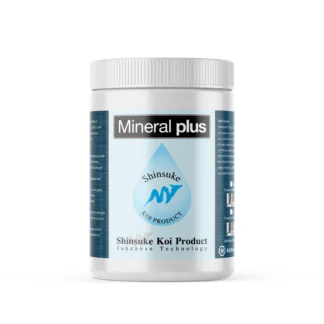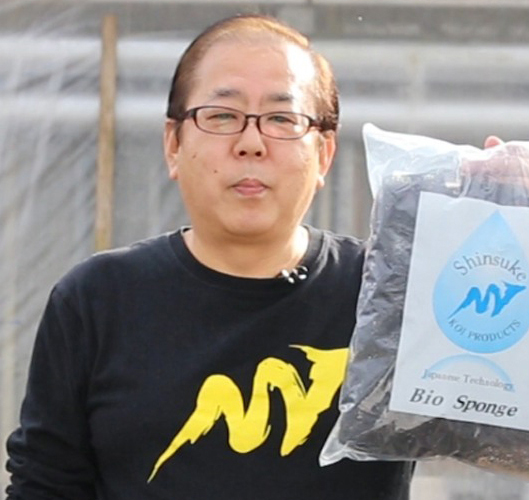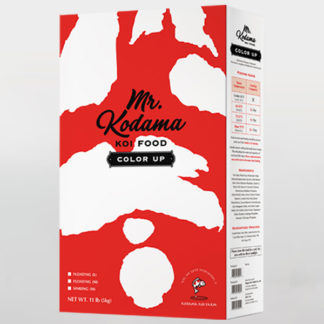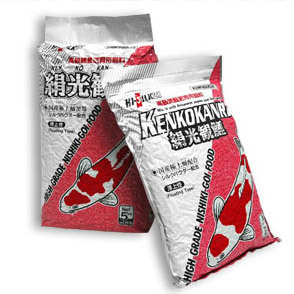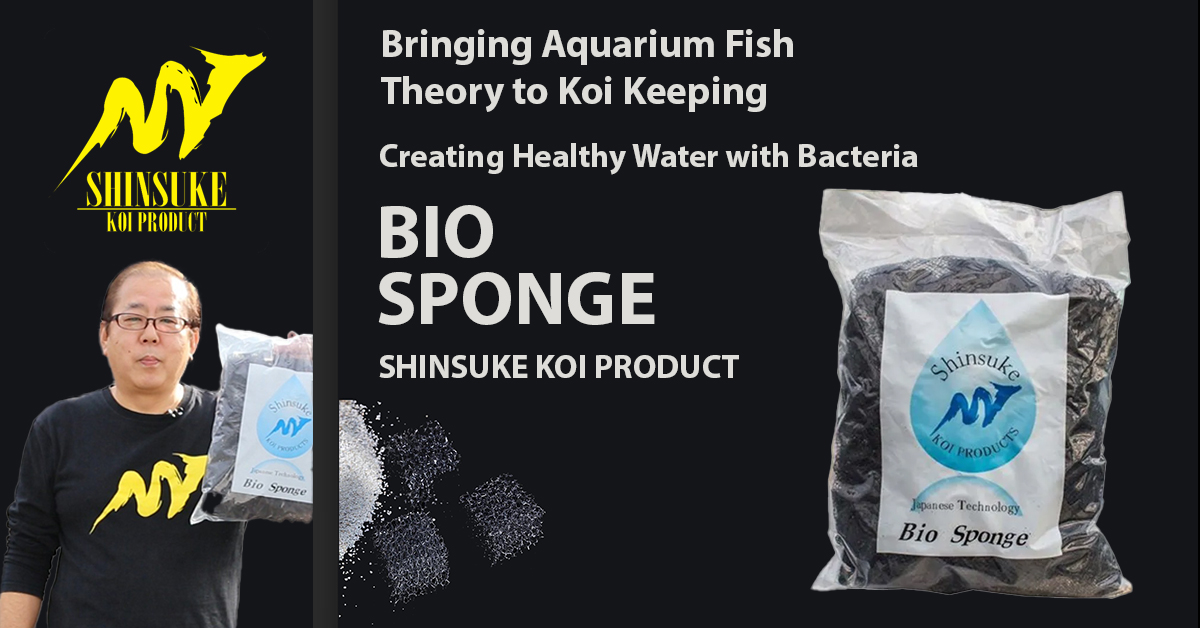
BIO SPONGE filter for koi pond health
RINKO MAGAZINE Interviewer: During an interview with a koi enthusiast, I heard someone say, “This filter media is excellent.” That product was Shinsuke Co., Ltd.’s “Bio Sponge.”
Read on to learn from this water quality expert, on how this seemingly ordinary sponge, has a special effect, and works as BIO SPONGE filter to efficiently create better overall water quality in your pond. Use Shinsuke Bio Sponge combined with Shinsuke Bacto Power for the best result.
Affordable Biological Filters and Minerals for Koi Ponds
Interview with Yoshihiro Yamamura on Shinsuke Method
Yoshihiro Yamamura, CEO and developer of Shinsuke Co., Ltd., has been involved with the tropical fish industry for many 35 years, learning and practicing theoretical water purification. Many famous koi farms such as Sakai Fish Farm, Dainichi Koi Farm, Isa Koi Farm and more have recognized the effectiveness of Shinsuke Koi products. This time, we talked about bacteria.
In this interview, we talked about the importance of Beneficial bacteria for koi ponds
Yamamura: Where do you think bacteria mostly live?
Interviewer: In filter media, right?
Yamamura: That’s common knowledge among koi enthusiasts, but in nature, bacteria are said to live mostly in “biofilms.”
What is a “biofilm”?
Yamamura: When you put flowers in a vase for a while, you’ll see a slimy film form. That’s a biofilm. Other examples include dental plaque and the slime on river rocks. Biofilms are structures created by microorganisms. You can think of them as densely populated bacterial cities.
Yamamura: Most bacteria on Earth live in biofilms. In water, the density of bacteria inside biofilms can be hundreds to thousands of times higher than outside. Biofilms are even used in sewage treatment plants to clean wastewater.
Interviewer: So, biofilms are cozy places for bacteria. If there are many biofilms in a filter tank, it will produce good water. How do biofilms form?
Yamamura: Organic matter and ions in the water stick to a surface, forming a “conditioning film.” Bacteria then start to attach to this film. They repeatedly settle and detach, increasing in number. They produce EPS (extracellular polysaccharides) which form colonies, eventually creating a biofilm structure.
Interviewer: So biofilms form on a “substrate.” Whether the substrate is suitable for forming biofilms seems key to bacteria doing their job.
Yamamura: Most koi filter media I’ve seen are good for removing large debris. Since koi produce a lot of waste, this makes sense. But, these media aren’t great for water purification using bacteria. Removing visible debris alone doesn’t create good water for koi. Bacterial water purification is important. Porous materials are said to be good for bacteria, so I thought mats would work, but…
Regular filter mat media are relatively smooth, making it hard for bacteria to settle. When new, they repel water, causing bacteria to wash away easily, taking longer to form biofilms. Our “Bio Sponge” uses a special material called “hydrophilic polyurethane,” making it easier for bacteria to settle. The special component is top secret though (laughs).
What is “hydrophilic polyurethane”?
Yamamura: It’s a material that easily mixes with water, has a high bacteria settling rate, and doesn’t break down easily, so it lasts long.
Interviewer: So it’s different from the commonly used filter media.
Yamamura: It also has a three-dimensional structure like a loofah, creating random water flow. This causes water to stagnate, making it easier for bacteria to break down organic matter. Water flows slowly in all directions, making it easy for biofilms to form inside and out. If it were just a sponge, biofilms would only form on the outside, which is wasteful.
Interviewer: Bio Sponge’s shape is ideal for purifying koi pond water and is suitable for bacteria to live in. I’ve heard from experienced hobbyists that “water should flow slowly through the filter system.” This media seems to put that idea into practice.
Yamamura: Think of an assembly line. It’s easier to work when the conveyor belt moves slowly. Bacteria are doing the job of breaking down waste. If the water moves slowly, bacteria can work more efficiently. If it flows too fast, dirty water goes back to the pond.
Interviewer: Even if water passes through the filter tank, if bacteria can’t do their job, dirty water just returns to the pond. Koi would suffer in such an environment.
Yamamura: That’s right. Additionally, the “Bio Sponge” is resistant to UV rays and keeps its shape even when submerged in water.
Interviewer: It sounds perfect. But what about clogging?
Yamamura: We designed it with the right spacing for koi water treatment. Tropical fish sponges are more tightly packed. Also, using it with “Bacto Power” helps break down sludge, so we haven’t had any clogging issues reported. However, if there’s a lot of large debris floating around, that’s a different story.
Additionally, the “Bio Sponge” is resistant to UV rays and maintains its shape in water. But if there’s a lot of large debris, the bacteria can’t handle it all, so pre-treatment is necessary. Most hobbyists have separate chambers of filteration, using traditional media for large debris and “Bio Sponge” for biological filtration, which seems effective.
The “Bio Sponge” is best placed at the end of the filter tank. Use one to two bags per ton of water.
By using “bacto power,” sludge is broken down, and we haven’t had any clogging issues. But again, if there’s a lot of large debris, it’s a different story.
Interviewer: That sounds easy. Good bacteria thrive in a comfortable environment, which helps purify the water and creates a healthy living space for koi.
Yamamura: The “Bio Sponge” also includes maifan stone, aiming for mineral benefits. Once the living conditions are set, mineral intake is crucial to activate the koi. Healthy and beautiful koi rely on minerals. Next time, I’d like to talk more about that.
Interview To Be Continued…
How Bio Sponge is used sample videos
This is how Sakai Fish Farm uses Bio Sponge
Other Articles About Water Quality by Shinsuke and Kodama
Beneficial Bacteria for Creating Healthy Water in Your Pond
The Power of Minerals in Enhancing the Beautiful Colors and Luster of Koi
You may also check these articles for more Pond Water Quality Tips
Pond Water Quality Management and Testing for Healthy Koi
What Kind of Water is Best for Koi?
When was the last time you changed your pond water?
View All Shinsuke Water Treatments for Healthy Water
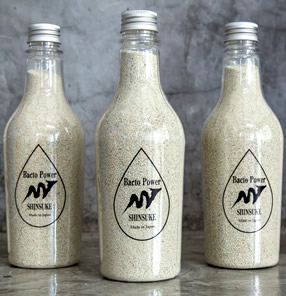
Bacto Power
$55.00Now introducing Bacto Power to our product range. BACTO POWER is a revolutionary water conditioner with a unique blend of facultative anaerobic bacteria, proteolytic enzyme and more than 10 different kinds of aerobic bacteria.
BACTO POWER provides your Koi with ideal environment by
- Helping in the decomposition of organic matter
- Stabilizing pH
- Preventing pollution (Nitrate reduction)
- Promoting the formation of an effective ecosystem
BACTO POWER is cultured and dried to pure at the pharmaceutical level with advanced Japanese microorganism technology.
Improve the health of your pond water and keep pH stable with Bacto Power.
Out of stock
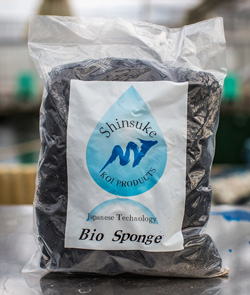
Bio Sponge
$45.00This seemingly ordinary sponge, has a special effect . The material of Shinsuke Bio Sponge is a particular sponge-like material, specifically invented and designed for forming BIO FILM. As such, Shinsuke Bio Sponge has a high retention ratio for bacteria, which is hard to reduce, even when located under water. Shinsuke Bio Sponge is UV ray resistant and is designed for multi-bay filters but is also suitable for moving – bed filters! Use Shinsuke Bio Sponge combined with Shinsuke Bacto Power for the best result.
Improve your water quality with, Bio Sponge’s high retention ratio for bacteria, which is hard to reduce, even when located under water or by exposure to ultraviolet rays.
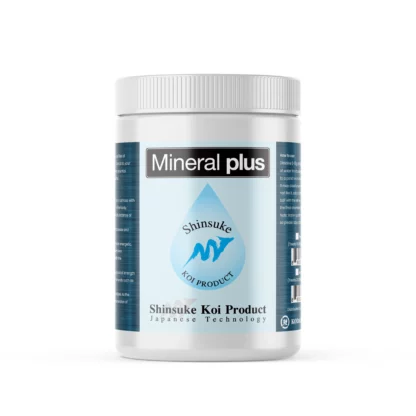
Mineral Plus
$60.00 – $120.00Mineral Plus is our new product, developed on our Shinsuke koi product concept, “Making koi more beautiful with the ideal surrounding.”
Koi in a Japanese mud pond get a lot of natural minerals, which very often are missing in a concrete pond. These minerals provide better growth, good structure and a healthy immune system . Shinsuke Mineral Plus also ensures the colors of the Koi come up well. Shinsuke Mineral Plus is a mixture of natural minerals and trace elements, but it’s most unique by the extra micro minerals.
Add minerals to make pond water the same quality as mud pond water.

